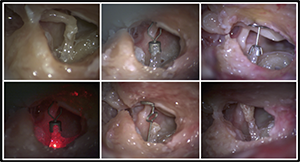
Photos of specimens implanted with different adjustable ossicular replacement prostheses. Clockwise from upper left: intact, adjustable partial ossicular replacement prosthesis (A-PORP), PORP, incus PORP, adjustable total ossicular replacement prosthesis, A-PORP under laser Doppler vibrometry.
© 2016 The American Laryngological, Rhinological and Otological Society, Inc.
Does an adjustable ossicular replacement prosthesis (ORP) allow for easier optimal device placement?
BOTTOM LINE
An adjustable ossicular replacement prostheses (ORP) allows for in situ length adjustment and easier alignment and tension optimization in ossiculoplasty, and they represent a promising new direction for the devices.
Explore This Issue
November 2016Background: Ossicular reconstruction surgery is a commonly performed procedure in the case of a discontinuous or fixed ossicular chain, and there exists a variety of ossicular replacement prostheses (ORPs) that have been designed for this purpose. Previous studies have examined the relative efficacy of different prosthesis designs, but the results of these studies vary widely. A number of studies have shown that the performance of an implanted ORP depends highly on its position, alignment, and tension between the tympanic membrane (TM) and the stapes head or footplate. Because of this, there has been interest in the design of adjustable-length prostheses that can be fit to the exact anatomy of an individual ear to optimize placement.
The goal of this study was to establish a basis for future work on the design of a new adjustable ORP by testing whether the addition of this flexible element degrades the acoustic performance of the prosthesis relative to standard prostheses commonly used for ossiculoplasty, such as a nonadjustable titanium ORP or a sculpted autologous incus prosthesis (I-PORP).
Study design: A 3D laser Doppler vibrometry system was used to simultaneously measure vibration velocity along three orthogonal axes, and the resultant 3D motion of a single point on the stapes from 0.2 to 20 kHz is reported for the first time. These measurements were performed on both normal ossicular chains and those reconstructed using the new adjustable ORP, a standard ORP, and an a sculpted autologous incus prosthesis I-PORP placed between the stapes head and either the TM or the manubrium.
Synopsis: In this study, a novel ORP with a flexible element that may allow for length adjustment in situ is presented and tested for acoustic performance. The device has an initial compact length that makes it easy to insert and align through the facial recess before the flexible element is expanded to achieve optimal tension.